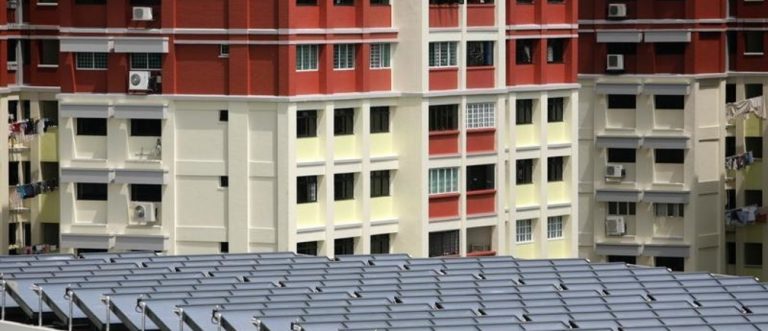Five building blocks for the homes of the future
Sue Riddlestone, co-founder and CEO of the BioRegional Development Group, offers her five building blocks for the homes of the future.
[edit] Introduction
How will we sustain 9 billion people in a resource-constrained world when everyone wants the good life? There just aren’t enough resources to go around – we would need three planets to support this lifestyle for 9 billion of us.
What we have found at BioRegional is that offering something different, such as a home that enables a one-planet lifestyle, it brings a surprising number of other benefits, including better health and quality of life for residents and improved sales, retention and resale.
So how can we build and manage the environmentally friendly homes and neighbourhoods of the future, for rich and poor alike?
I think there are five keys to sustainable homes for 9 billion people:
[edit] Energy saving and renewable generation with local storage and grids
Homes need a lot of energy to keep warm or cool, for lighting, hot water and the ever multiplying gadgets. If we are going to sustain 9 billion people we need net zero carbon homes that are resource efficient in operation and that act as mini power stations.
They could, for example, have building-integrated photovoltaics (PV) and could be supplied by local renewable electricity and heat grids. Energy storage and direct current LED lighting are two ways to make building-integrated PV work well.
This approach is already being developed at the Bicester eco town in Oxford, UK. In Guangzhou, China the 6,000-home Jinshan community draws on traditional methods like high ceilings and shading to reduce the need for air conditioning.
With energy prices rising there is now a huge market for energy retrofitting in existing homes. The Rockefeller Foundation found that in the United States alone, an investment of $279 billion could yield more than $1 trillion of energy savings over 10 years, creating 3.3 million cumulative job years of employment.
All over the world we will need totally decarbonised electricity grids by 2050. The European supergrid is one exciting idea. And in the poorest of homes that have yet to get on the grid, going renewable will reduce the need for expensive energy infrastructure through mini-grids.
[edit] Walkable communities and higher density living
We can’t consider our homes in isolation – what happens when we walk out of the front door? Where are the shops, the schools, the public transport?
In the United States, the financial crisis led to a flight from the suburbs as people couldn’t afford high gas prices for their cars. Now, skinny homes are the new trend in North America, fitting two or more homes in urban areas where one stood before. This is not just an issue for the wealthy, and poorer people are often priced out of the central locations where they work. The latest UN Habitat report highlights the need for access, as opposed to just planning for transport
[edit] Connected living
Technology is transforming our home lives and it can enable sustainable living. Tablets can be used to tell us our energy consumption, the time of the next bus or train, to book a vehicle through a car club or to browse local second-hand items or services.
As we order more of our goods online, our homes are now our shopping centres, to the detriment of the traditional high street and shopping malls. Instead, we are seeing more high street community hubs where people can pick up their Internet deliveries, work locally, buy a coffee and meet their neighbours. Mobile phone technology is similarly transforming the lives of the poorest with mobile banking, health and education services already well established.
[edit] Building less, refurbishing and building smarter
At the London 2012 Olympics, a study found that most of the environmental impact wasn’t people flying in, it was the construction. By opting for lower impact materials, leaner buildings and infrastructure and avoiding wasting materials, London slashed the carbon footprint by 20% and cut costs, too. This sort of approach should be applied across all construction and refurbishment.
[edit] Government strategies and finance for infrastructure and affordable homes for the poorest
For 30 years, governments have increasingly followed a 'leave it to the market' approach to housing. As a result, many poorer people are unable to live in a decent home. Social housing is not only a social good – it is also a good investment. If you build someone a house, they will pay you rent, which will pay back the capital expenditure in time. Better than that, in such a home children will thrive and social problems, which cost society money, are reduced.
With the population of urban areas set to increase, especially in Asia and Africa, it’s important that we build affordable and sustainable homes. All the data shows that sustainable homes and communities are better for people, better for business and essential if we are to sustain a world of 9 billion.
Author: Sue Riddlestone is co-founder and chief executive officer of the BioRegional Development Group. She is a Schwab Foundation Social Entrepreneur.
[Image: Solar thermal collectors are seen against a backdrop of public housing flats on the roof of a building at the United World College of South East Asia (UWCSEA) East Campus in Singapore. REUTERS/Tim Chong]
This article was originally published on the Future of Construction Knowledge Sharing Platform and the WEF Agenda Blog.
--Future of Construction 16:31, 15 Jun 2017 (BST)
[edit] Related articles on Designing Buildings Wiki
Featured articles and news
RTPI leader to become new CIOB Chief Executive Officer
Dr Victoria Hills MRTPI, FICE to take over after Caroline Gumble’s departure.
Social and affordable housing, a long term plan for delivery
The “Delivering a Decade of Renewal for Social and Affordable Housing” strategy sets out future path.
A change to adoptive architecture
Effects of global weather warming on architectural detailing, material choice and human interaction.
The proposed publicly owned and backed subsidiary of Homes England, to facilitate new homes.
How big is the problem and what can we do to mitigate the effects?
Overheating guidance and tools for building designers
A number of cool guides to help with the heat.
The UK's Modern Industrial Strategy: A 10 year plan
Previous consultation criticism, current key elements and general support with some persisting reservations.
Building Safety Regulator reforms
New roles, new staff and a new fast track service pave the way for a single construction regulator.
Architectural Technologist CPDs and Communications
CIAT CPD… and how you can do it!
Cooling centres and cool spaces
Managing extreme heat in cities by directing the public to places for heat stress relief and water sources.
Winter gardens: A brief history and warm variations
Extending the season with glass in different forms and terms.
Restoring Great Yarmouth's Winter Gardens
Transforming one of the least sustainable constructions imaginable.
Construction Skills Mission Board launch sector drive
Newly formed government and industry collaboration set strategy for recruiting an additional 100,000 construction workers a year.
New Architects Code comes into effect in September 2025
ARB Architects Code of Conduct and Practice available with ongoing consultation regarding guidance.
Welsh Skills Body (Medr) launches ambitious plan
The new skills body brings together funding and regulation of tertiary education and research for the devolved nation.
Paul Gandy FCIOB announced as next CIOB President
Former Tilbury Douglas CEO takes helm.
UK Infrastructure: A 10 Year Strategy. In brief with reactions
With the National Infrastructure and Service Transformation Authority (NISTA).
























